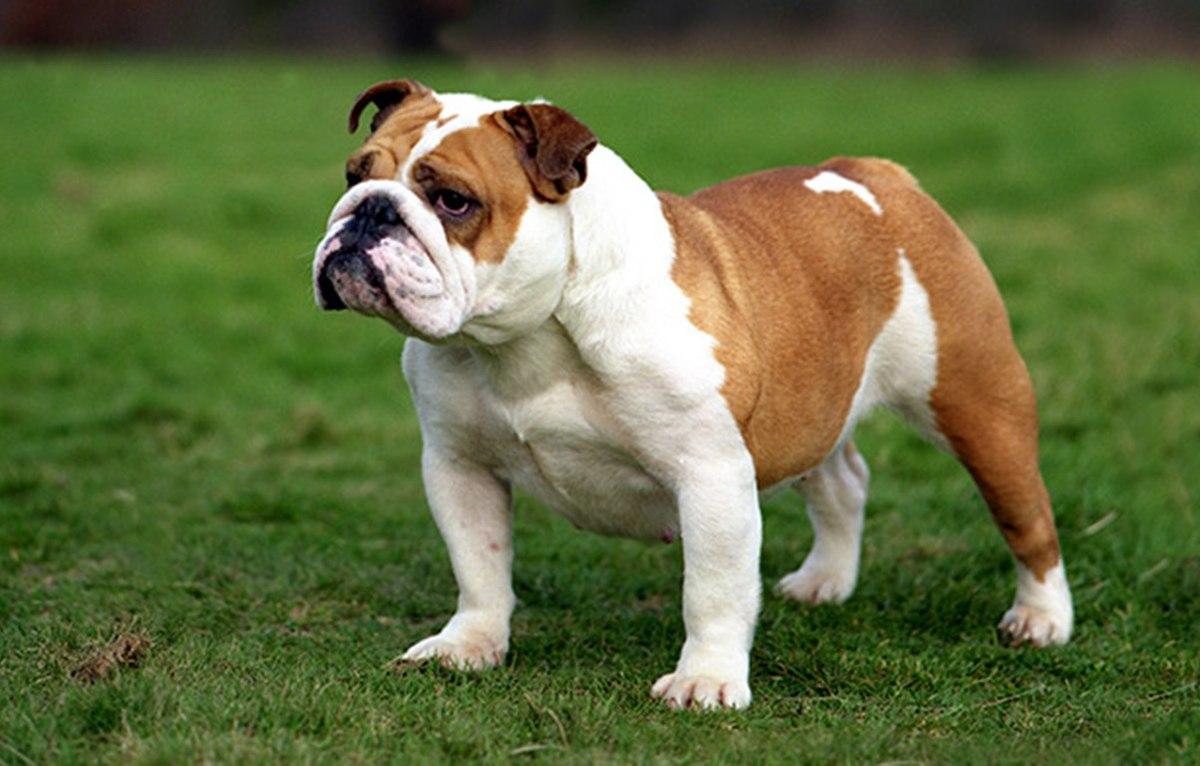In this article we are going to acquaint ourselves with the dog that has a vicious appearance, but which in reality is a real softie with a heart of gold.

The English Bulldog, sometimes known as the British Bulldog, has a violent history that led to the breed’s name.
Bullbaiting was a brutal sport that involved the employment of mastiffs, which the Romans imported to the British Isles and bred for combat.
However, modern Bulldogs look very different from their progenitors.
What about all of their fierceness in the bullbaiting arenas?
We can assure you that aspect of their personality went away for good.
You’d be difficult-pressed to find a dog with a kinder, gentler personality, even though they still have an iconically fierce look.
It’s impossible to confuse a bulldog with any other kind of canine due to their very distinct appearance.
They’re around the size of a medium dog and have a stocky, low build.
They don’t have a long muzzle to accompany their big and square head.
Rather, their muzzle is narrow and more or less “squished in.”
Their limbs are robust and sturdy, and they have large shoulders and chests.
Fast Facts About English Bulldogs
Origin: England
Life span: 8–10 years
Weight: 40-50 pounds
Height: 13–15 inches
Breed group: Non-sporting

Appearance
Most people think of English bulldogs (also known as British bulldogs) when they hear the word “bulldog,” although there are a bunch of different bulldog breeds, such as the French Bulldog.
The British Bulldog can be differentiated by means of their strong, short-legged, and wide-bodied build.
They weigh between 18 and 22 kilograms.
Their massive underbite is a defining (and outrageously adorable) characteristic, and it’s not uncommon for young dogs to “hang a fang.”
They have droopy skin, a rope for a nose, and wrinkles all over their face – all being features which they are famous for.
The English bulldog’s large shoulders and low stance served them well in the canine arena.
There are four recognized colors for these dogs, according to the American Kennel Club (AKC); these include red, white, fawn, and fallow. They can have additional brindling, ticking, black masks, or any mixture of the aforementioned colors. They almost always have black or very dark brown eyes.
An English bulldog is easily distinguishable from other canine relatives in the bulldog family.
The French Bulldog is a smaller breed with elongated ears that resemble those of bats.
The American Bulldog is a multitalented working breed with long legs and a slimmer build that makes it suitable for guard duty, hunting, and farm work.
The Old English Bulldog is the rarest bulldog type. It is a bigger, more muscular cross of English bulldogs, pit bull terriers, American bulldogs, and bullmastiffs.
Habitat and Distribution
The United States, the United Kingdom, Canada, Australia, and New Zealand are just a few of the numerous countries with bulldogs in their canine populations.
They are kept as pets in homes all around the globe and are famed for the devoted and friendly nature to which they are predisposed.
The ideal living environment for a Bulldog is properly ventilated and has enough space for the dog to run around and play. They do best in temperate regions and require consistent physical activity to maintain their health.
Also, Bulldogs are renowned for their toughness and intelligence, making them ideal pets for households with children.
Diet
High-quality dog food in the range of 1/2 to 2 cups per day, divided between two meals, is advised to keep your English Bulldog happy and healthy.
The amount of food your adult dog consumes is influenced by their size, age, build, digestion, and degree of activity. Because every dog is unique with specific nutritional needs, it would be unfair to assume that all dogs should be fed the same amount. It goes almost without saying that a hyperactive dog will need larger amounts of food than a less active dog. The quality of the dog food you buy matters as well; the better the food, the less you will have to shake into the dish. Moreover, the higher quality of food your dog is fed – the more likely it is that it will live a long life, meaning you get to spend more time with your four-legged best friend.
An overweight Bulldog’s joints will suffer; therefore, it’s important to watch their food intake. Accurately measure their food and feed them twice a day, instead of leaving it out all the time, to maintain your adult Bulldog in good form. Give them a quick physical assessment if you have doubts about whether or not your pupper is overweight. You should put your hands on their back, thumbs down their spine, and fingers stretched down. Without exerting too much pressure, you should be capable of feeling their ribs but not be able to see them. If not, you have to make sure that your dog eats less and exercises more. We know that it’s difficult to deny your four-legged best friend treats, especially when they weaponize their powerful puppy eyes – but remember that it is for their own best!
Mating
English Bulldogs reach sexual maturity between the ages of 6 and 8 months. Just because a female has reached sexual maturity does not guarantee that she can give birth to offspring.
At the age of six months, an English Bulldog’s bones are not entirely matured. Therefore, if a female is mated during her maiden heat, then the stress of the pregnancy will take a toll on her bones because they are not fully developed yet. This can frequently result in the dog developing persistent paralysis or other serious health issues.
English Bulldog males likewise attain sexual maturity at about 6 to 8 months, although optimum sexual maturity occurs around 12 months of age.
According to many breeders, the second heat or later is the best time to start breeding your female English Bulldog. To guarantee that your female is in the best possible condition to whelp a litter, some even further advise waiting until she is at least two years old.
Frequently, they will also have greater motherly intuitions and instincts when delaying mating until they are two years or older, which is helpful when ensuring their puppies’ health after birth.
Fun Facts and Interesting Features of Bulldogs
#1 Can’t Swim Properly
Not every dog breed was built for the Olympics, but an English Bulldog without a doggie life jacket would be in serious trouble in the water. This breed is disadvantaged by their short legs, squished-up faces, and stout bodies, all of which make them terrible swimmers.
#2 Two Presidents Had English Bulldogs
The English Bulldog was a popular breed during the time of Warren Harding and Calvin Coolidge, two presidents who both owned English Bulldogs. Harding had an English Bulldog during his time in office. Resultantly, his bulldog, named “Oh Boy,” was granted the title of First Dog – a truly presidential pupper.
#3 Called Churchill-Dogs
During WW2, the people of Britain oftentimes referred to the breed as “Churchill-Dogs.” This was so because they were both deemed to symbolize the strength and courage of England. What’s ironic about this, though, is that Churchill didn’t own an English Bulldog and in fact disliked the breed. Allegedly Poodles were his dog of choice.
#4 Many Bulldog mothers have C-sections
The safest delivery method for an English Bulldog is a C-section due to their huge heads. This delivery method is used in about 80% of litters to reduce the possibility of a puppy being lodged in the birth canal, posing a huge danger both to the mother and her offspring.
FAQs
What is the temperament of a Bulldog?
Bulldogs are known to be gentle, friendly, loyal, and courageous. They are usually calm and tolerant but may be stubborn at times.
How much exercise does a Bulldog need?
Bulldogs usually require moderate exercise, such as a daily walk or games of fetch. Dog experts advise that they shouldn’t get more than an hour of exercise a day so as to not overexert them – although this varies greatly from individual to individual. It is also recommended that they receive numerous shorter walks rather than one long one.
How Much Do Bulldogs Shed?
Bulldogs are generally low-shedding dogs, but they do shed. Regular brushing with a slicker brush can help manage any shedding.
Are Bulldogs Good With Children?
Yes, Bulldogs can make excellent family pets and are good with children. It is important to socialize Bulldogs early and supervise them around small children before they become acquainted.
What Is the Life Expectancy of an English Bulldog?
The average life expectancy of a Bulldog is between 8-10 years. They can live longer with proper care, diet, and regular vet check-ups.
Conclusion
The English Bulldog gives off a tough impression due to its low-slung and well-muscled body.
Their history of being used in dog fighting also adds to their reputation as aggressive dogs.
However, this is far from the truth. English Bulldogs are extremely loving and cuddly companions.
They are impeccable family dogs that do well with children.
Due to their moderate exercise requirements, they are also very low-maintenance dogs, and so are their grooming needs.
Likewise, they can do well in smaller spaces or apartments and therefore make great city-dogs.

Last Updated: 25-02-2023





